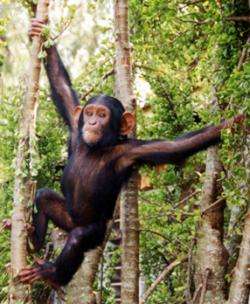Monkeys draw novel conclusions, researchers say

Monkeys keep turning out to be smarter than people think they are. Researchers have shown that they can count to four and are aware of differences between languages like Dutch and Japanese, even though they don't known what is being said. Now, Harvard psychologists find that monkeys can draw correct conclusions about novel situations. For example, shown a white towel that turns blue, a blue knife, and a glass of blue paint, they can figure out that the paint not the knife is responsible for the change in color.
"Our studies reveal a striking continuity between humans and monkeys in their capacity to draw causal inferences without the help of familiarity with the events or situation," says Marc Hauser, a Harvard professor of psychology. "This ability highlights the richness of the monkey mind in terms of its understanding of the material world."
Hauser has been working with a colony of free-ranging rhesus monkeys on an island off Puerto Rico for many years. He and Bailey Spaulding, formerly a student of his, tested individual adult males and females of the colony on their ability to figure out cause and effect in unfamiliar situations.
In their experiments, they used a glass of water and a knife along with a whole apple and an apple cut in half. The knife can halve the apple, but the water can't. Do the monkeys grasp this?
In one set of tests the monkeys saw a glass of water and two whole apples. Then they viewed a knife being lowered and the apple cut in half. These are two perfectly plausible situations. Next, they saw the glass of water and two halves of an apple. Following this, a knife was lowered, and two apple halves seemingly became a whole apple.
To a human, even an infant who had never seen such things before, the last two apparent happenings would never really happen. Can monkeys infer the same outcomes? Evidently, the answer is "yes." They looked longer when a glass of water appeared to cut the apple than when a knife seemed to do the same. The longer look signaled disbelief.
None of the monkeys had previous experience with knives or other tools, in contrast to apes like chimpanzees who demonstrate such know-how in the wild. They pull leaves off twigs and use them to dig edible termites out of holes. Vervet and cotton-top tamarin monkeys show what Hauser calls "quite exquisite sensitivity" to tools and competence for using them. However, he continues, "There were no reports of wild rhesus monkeys using tools or, for that matter, of them showing any interest in object manipulation, so one might expect failure."
Surprisingly, they didn't fail. Without ever having seen a glass of water and two apple halves, or a blue knife and blue and white towels, the monkeys inferred that water cannot cut fruit and knives can't change the color of towels.
Looks of disbelief
Rhesus monkeys can't speak, so how do the investigators know if they think something is possible or not? They rely on a thoroughly tested method in which the amount of time spent looking at something provides a measure of expectancy or belief.
Researchers have used this method in hundreds of studies of human infants, apes, and monkeys. Hauser employed it in his study of speech recognition by cotton-top tamarin monkeys. They looked at a speaker broadcasting sentences in Dutch, a novel sound for the monkeys. When they had heard enough to be bored they turn away. When the language switched to Japanese, they looked back with renewed interest. Infants show the same behavior.
To rule out any bias by the scientists, the monkey looks were video recorded, and a team of timers measured the lengths of the looking without knowing what the animals saw.
The experiments, then, answer a key question about human versus monkey intelligence. Is the capability for figuring out what is possible and not possible when you see something for the first time uniquely human? For Hauser, Spaulding, and a lot of scientists who read their report in the May 2 issue of the Proceedings of the National Academy of Sciences, the answer is a resounding "No."
"Humans are not alone in their capacity to draw causal inferences from limited experiences," the Harvard researchers write. "This capacity is part of the evolved psychology of rhesus monkeys and most likely other animals as well."
This monkey business bears on a deeper philosophical question, as the researchers point out. The British philosopher David Hume, in his 1739 tome, "A Treatise of Human Nature," argued that no evidence exists of cause in the world. He claimed that cause is inferred when a person frequently sees two well-known events occurring together. Psychologist David Premack, in his "Original Intelligence," published in 2002, admitted that, although Hume's logic was sound, his psychology was not. As Hauser and Spaulding point out, "Cause is often inferred by human adults and infants from single novel events. As an example, when 27-week-old infants see, for the first time, a moving block hit a stationary block, they can figure out what happened. On the other hand, when humans see day following night, they don't assume that night causes day.
Animals seem able to make the same type of distinction, and a bunch of monkeys in Puerto Rico have made monkeyshines out of Hume's idea.
Source: Harvard University, by William J. Cromie

















